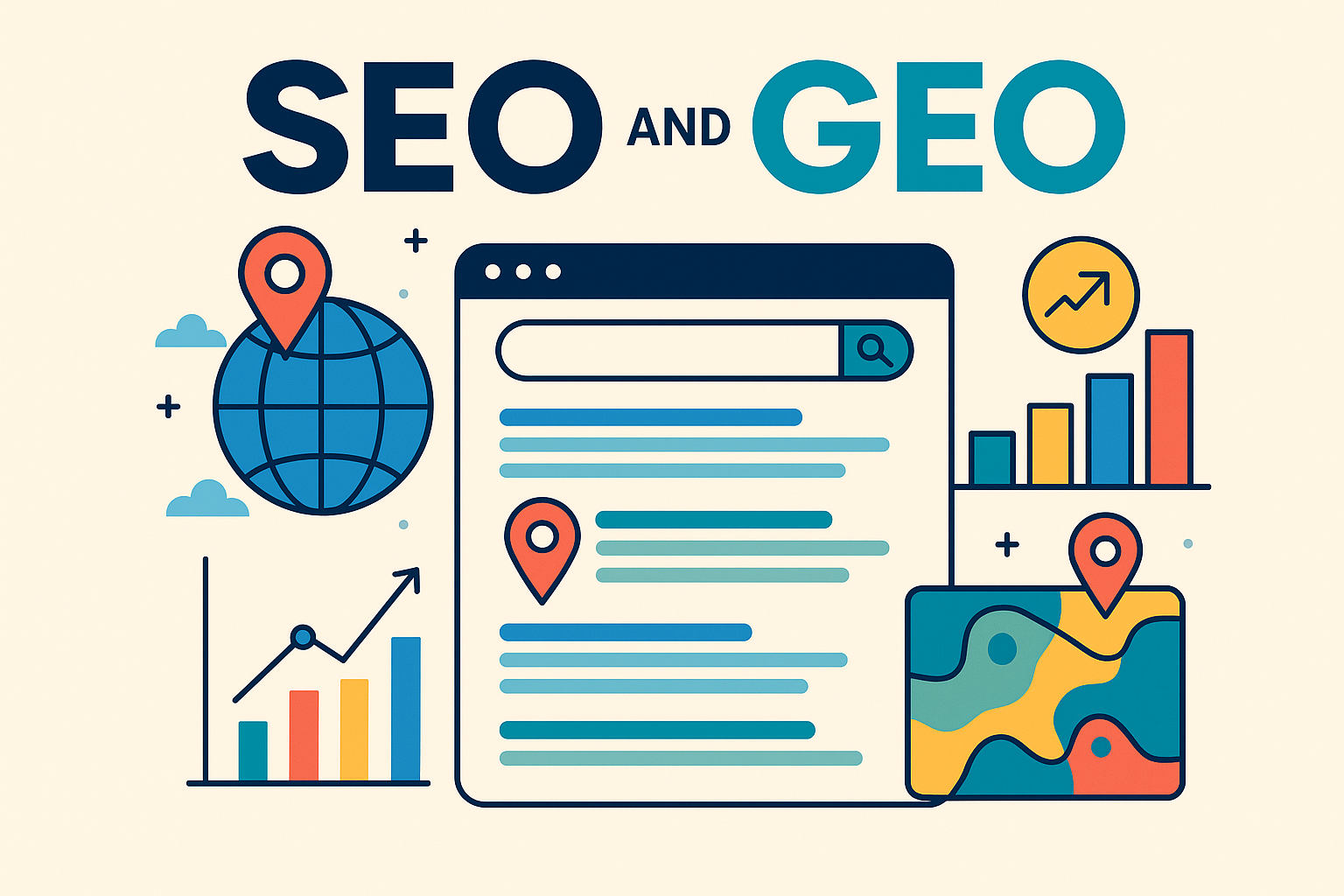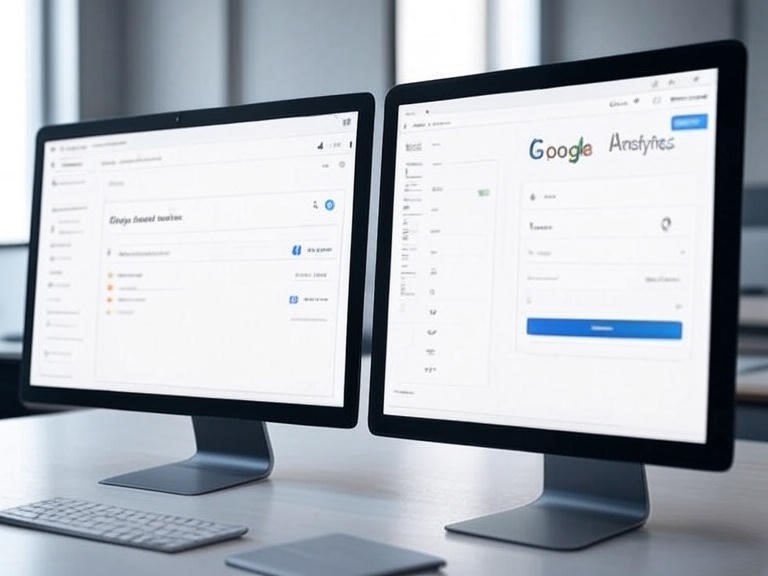
Table of Contents
1. Introduction
Search engines are smarter than ever—and so are users. As the digital landscape evolves, search engine optimization (SEO) is no longer just about keywords and backlinks. It’s also about where users are searching from. Enter GEO SEO, the art and science of optimizing digital content for location-based searches.
In this blog post, we’ll explore how GEO and SEO intersect, why local optimization matters, and how your business can stay competitive in this location-first era.
2. What Is SEO and GEO?
SEO stands for Search Engine Optimization—a process that helps improve the visibility of a website in organic search results.
GEO, in the context of SEO, refers to geographic targeting, also known as geotargeting. It’s a method where search results are tailored based on the searcher's location.
🔍 Example:
A user in Dallas searching for “best coffee shop” will see different results than a user in San Francisco—thanks to GEO-targeting.
3. The Rise of Location-Based Searches
Over the past few years, mobile-first indexing and voice search have led to a surge in “near me” and location-specific queries.
📊 Location-Based Search Growth Chart
| Year | % of Searches Containing "Near Me" |
|---|---|
| 2018 | 46% |
| 2020 | 60% |
| 2023 | 78% |
| 2025 (est.) | 85% |
Source: Google Trends, Think with Google Reports
4. Benefits of GEO-Focused SEO
| Benefit | Explanation |
|---|---|
| 🎯 Better Targeting | Connects your business with users near your location. |
| 📈 Higher Conversion Rates | Local intent = higher chance of action (e.g., call, visit, purchase). |
| 📍 Google Maps Visibility | Increases chances of appearing in local pack results. |
| 💬 Improved Trust | Local listings and reviews build credibility. |
| 📱 Optimized for Mobile | Most GEO searches happen on mobile devices. |
5. How Google Uses Location Data
Google uses several data points to determine a user’s current location:
- IP address
- GPS coordinates (on mobile)
- Wi-Fi & cell tower data
- Search history and Google account location
- Language and region settings
This data helps Google serve hyper-relevant local results to the user.
6. Core GEO SEO Strategies
To fully benefit from the powerful blend of SEO and GEO, businesses must adopt a layered approach that aligns local intent with location-based SEO techniques. Whether you're managing a chain of physical stores, a single-location service, or a location-specific landing page strategy, these GEO SEO strategies will help you rank higher, attract relevant traffic, and convert local customers more efficiently.
By leveraging these methods, small and medium enterprises (SMEs) can maximize their SEO for small business efforts and stand out in Google Maps SEO results and the coveted local 3-pack.
📍 Key GEO SEO Strategies
1. Google Business Profile Optimization
Your Google Business Profile (GBP) is the cornerstone of effective local SEO. It feeds data to Google Maps and enables your business to appear in location-based searches and the local pack.
- Ensure your business name, address, phone number, hours of operation, and website URL are accurate and up to date.
- Upload high-quality local images, including storefronts, interiors, and staff photos.
- Actively manage and respond to customer reviews, which signals trust and engagement to search engines.
- Use the “Products” and “Services” features to highlight what you offer in specific locations.
This directly improves your visibility in Google Maps SEO and helps your brand gain trust in your geographic niche.
2. Local Keyword Optimization
For successful geotargeting, your SEO strategy must incorporate keywords that reflect your location-based services.
- Use geo-modified keywords like “plumber in Austin,” “Miami car repair,” or “best bakery near downtown NYC.”
- Integrate neighborhoods, suburbs, ZIP codes, and local landmarks into your content and metadata.
- Conduct local keyword research using tools like Google Keyword Planner, SEMrush, or BrightLocal to uncover high-volume regional terms.
Local keyword optimization is the foundation of location-based SEO, ensuring your content aligns with real user intent in specific areas.
3. Location-Specific Landing Pages
Create individual landing pages for each location or service area you serve. These help search engines and users identify the relevance of your content to their specific geographic query.
- Example:
/services/plumbing-houston/or/locations/new-york/brooklyn-pediatrics/ - Include unique local content: testimonials from that area, a map, driving directions, and contact details.
- Embed a Google Map on the page and add structured data to help with Google Maps SEO.
These pages are critical to building domain authority across multiple cities or regions and are an essential part of SEO and GEO integration.
4. NAP Consistency Across All Channels
NAP stands for Name, Address, and Phone Number, and its consistency across the web is vital to local SEO success.
- Ensure your NAP is identical across your website, Google Business Profile, Yelp, Facebook, Yellow Pages, and industry-specific directories.
- Mismatched or outdated details can confuse both users and search engines, leading to ranking drops in geotargeted search results.
Tools like Moz Local, Yext, and BrightLocal can help monitor and correct NAP inconsistencies, especially for businesses with multiple locations.
5. Local Citations and Directory Listings
Citations are mentions of your business information on external websites, and they play a big role in local search rankings.
- List your business on reputable platforms such as Yelp, Foursquare, Apple Maps, Bing Places, Justdial (India), Yellow Pages, and industry-specific directories.
- Each citation acts as a trust signal, especially when paired with consistent NAP and customer reviews.
- Include geo-specific keywords in descriptions wherever possible.
Building citations is one of the most cost-effective and impactful tactics in SEO for small business.
6. Structured Data Markup (Schema.org)
Implement structured data markup (also known as schema) on your website to help search engines understand your local content.
- Use schema types such as:
LocalBusinessPostalAddressGeoCoordinatesopeningHours
- This improves eligibility for rich results like star ratings, map pins, FAQs, and more in SERPs.
- It enhances Google Maps SEO visibility and helps search engines index your local data accurately.
For instance, if you operate a multi-location business, applying separate LocalBusiness schema for each branch helps your brand appear for multiple location-based SEO searches.
7. Mobile Optimization for Local Intent
The majority of GEO-targeted searches happen on mobile devices—think “coffee shop near me now”. Your website must be mobile-friendly to capture and convert these high-intent users.
- Use responsive design to ensure pages load well across all devices.
- Improve page speed, especially for mobile visitors using cellular data.
- Add click-to-call buttons, map navigation links, and location-specific CTAs.
Mobile optimization enhances the user experience and plays directly into the SEO and GEO synergy that search engines prioritize in 2025 and beyond.
🧭 Summary Table: GEO SEO Strategy Checklist
| Strategy | Purpose | Keywords Applied |
|---|---|---|
| Google Business Profile | Improves local pack and Maps ranking | Google Maps SEO, SEO and GEO |
| Local Keyword Optimization | Matches user intent with localized content | Geotargeting, location-based SEO |
| Location-Specific Landing Pages | Boosts visibility for specific service areas | SEO for small business, local SEO |
| NAP Consistency | Builds trust and authority across platforms | Local SEO, geotargeting |
| Local Citations | Strengthens domain trust and local signals | SEO and GEO, SEO for small business |
| Structured Data Markup | Enables rich snippets and precise data parsing | Location-based SEO, Google Maps SEO |
| Mobile Optimization | Captures mobile local traffic and conversions | Local SEO, geotargeting, SEO and GEO |
This strategic blueprint equips businesses of all sizes—especially those relying on SEO for small business success—with the tools they need to dominate in location-specific search and stay ahead in a rapidly evolving search ecosystem.
7. GEO SEO for Different Business Types
| Business Type | GEO SEO Tactic |
|---|---|
| 🏥 Healthcare | Location pages for each clinic, doctor profile SEO, map embeds. |
| 🍕 Restaurants | Menu optimization, reservation integrations, review management. |
| 🧰 Home Services | Service area map, city-specific testimonials, emergency contact info. |
| 🏨 Hospitality | Local attractions content, multilingual SEO, booking engine integration. |
| 📚 Educational | Campus pages, location-based events, maps for directions. |
8. Tools for GEO SEO
| Tool Name | Function |
|---|---|
| Google Business | List and manage your local business. |
| BrightLocal | Track local rankings, audit citations. |
| Moz Local | Monitor and distribute local listings. |
| SEMrush | GEO-based keyword research and competitor analysis. |
| Whitespark | Citation building and local rank tracking. |
9. GEO SEO Performance Metrics
Track the following KPIs to evaluate your location-based optimization:
📊 GEO SEO Performance Table
| Metric | Why It Matters |
|---|---|
| Local Pack Impressions | Measures visibility in Google Maps results. |
| Click-Through Rate (CTR) | How many people clicked on your local listing. |
| Direction Requests | Shows how many users want to visit your location. |
| Calls from GMB | Indicates real-time engagement from mobile searchers. |
| Geo-Tagged Reviews | Boosts credibility and improves rankings. |
| Traffic by Region | Helps tailor content for specific cities/areas. |
10. GEO vs Traditional SEO
| Feature | Traditional SEO | GEO SEO |
|---|---|---|
| Keyword Focus | Broad (e.g., "digital marketing tips") | Local (e.g., "digital marketing NYC") |
| Audience | National/Global | City-specific or regional |
| Ranking Factors | Content, links, UX | Local reviews, proximity, citations |
| Visibility Goal | Organic SERP | Local Pack, Maps, Voice Search |
11. Common GEO SEO Mistakes to Avoid
- ❌ Ignoring Google Business Profile
- ❌ Using the same landing page for multiple locations
- ❌ Not using schema markup
- ❌ Inconsistent NAP across directories
- ❌ Forgetting mobile optimization
12. Future Trends in SEO and GEO
| Trend | Impact |
|---|---|
| 📱 Voice Search & Wearables | More searches like “nearest gas station” or “coffee nearby now.” |
| 🧠 AI-Powered Recommendations | Smart search systems like Google SGE will personalize local results. |
| 🗺 Hyperlocal Targeting | Block-by-block content strategies. |
| 🛰 Augmented Reality in Search | Google Lens + AR maps for physical store directions. |
| 🌐 Multi-language Local SEO | Multilingual content for immigrant/local communities. |
13. Conclusion
SEO and GEO are no longer separate silos—they’re converging into one powerful strategy that every modern business must embrace. From optimizing your Google Business Profile to creating localized content and structured data, GEO SEO is the bridge between your digital footprint and real-world visibility.
Whether you're a local cafe or a multi-city brand, mastering GEO-based SEO gives you an edge in hyper-competitive local markets.
14. FAQs : GEO SEO
Q1: What is GEO SEO?
A1: GEO SEO is the practice of optimizing your website and content to rank higher in location-based searches. It involves local keywords, citations, maps integration, and more.
Q2: How does Google determine location for GEO SEO?
A2: Google uses GPS, IP address, Wi-Fi data, and search history to detect your location and serve locally relevant results.
Q3: Is GEO SEO relevant for online-only businesses?
A3: Yes, especially if you target customers in specific cities or regions. Creating location-specific content and using regional keywords can help boost visibility.
Q4: Why are "Near Me" searches important for GEO SEO?
A4: "Near Me" searches, which grew from 46% in 2018 to an estimated 85% in 2025 (Google Trends, Think with Google Reports), reflect user demand for local results. Optimizing for these terms helps businesses capture high-intent local customers.
Q5: What are some key strategies for effective GEO SEO?
A5: Key strategies include optimizing Google Business Profile, using location-specific keywords, earning local backlinks, ensuring consistent NAP (Name, Address, Phone) citations, and creating localized content like city-specific landing pages.
Q6: How does mobile usage impact GEO SEO?
A6: Mobile devices drive GEO SEO due to their geolocation capabilities. With most users searching on smartphones, optimizing for mobile speed, local keywords, and map-based results is critical for ranking in location-based searches.
15. 🔑 Key Takeaways
- SEO and GEO Work Together: GEO-based SEO helps businesses appear in search results that are tailored to the user’s physical location, increasing visibility and relevance.
- Local Search Is Booming: Over 85% of mobile users conduct “near me” searches, making location-based optimization essential for local businesses.
- Google Uses Multiple Location Signals: Search engines consider IP address, GPS, Wi-Fi, and user history to serve geographically targeted results.
- Google Business Profile Is a Must: Accurate listings, reviews, and location photos significantly boost local search performance.
- Location Pages Improve Conversions: Creating separate landing pages for each city or region allows for more relevant content and better user experience.
- NAP Consistency Builds Trust: Ensuring your business name, address, and phone number are consistent across all platforms is key for ranking in local packs.
- Structured Data Helps Stand Out: Using LocalBusiness and geo schema markup improves your chances of appearing in rich search results.
- GEO SEO Isn’t Just for Brick-and-Mortar: Even online-only businesses can target specific regions or cities with localized content and ads.
- Metrics Matter: Monitor local impressions, CTR, direction requests, and reviews to measure your GEO SEO success.
- The Future Is Hyperlocal: With AI, AR, and voice search gaining ground, personalized, location-based results will dominate the search experience in the coming years.

📢 Disclaimer
The content provided on WordPress Guru Pro is based on personal experience, research, and practical use of tools like Elementor, Astra, and Rank Math. While I aim to offer accurate and up-to-date guidance, I am not liable for individual results or third-party plugin/theme performance. Always test tools before deploying on a live site.
This post reflects my role as a WordPress expert for beginners, and the article, "SEO and GEO: How Location-Based Optimization Is Shaping the Future of Digital Search" is intended for educational purposes only.
🔎 Some links on this page may be affiliate links, which means I may earn a small commission at no extra cost to you — I only recommend tools I personally use and trust, like Hostinger.
📩 Let’s Connect!
Need help with your WordPress site? Want to collaborate or ask a question?
👉 Contact Me
👉 Or email me directly: contact@wordpressgurupro.com
Thanks for visiting — let’s build something amazing together! Hope you enjoy my article,"10 Best Free WordPress Themes for Blogs in 2025"
While you’re here, don’t forget to explore our top resources:


